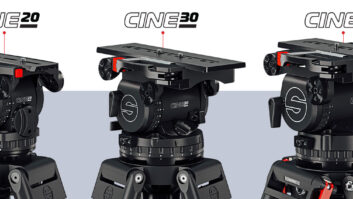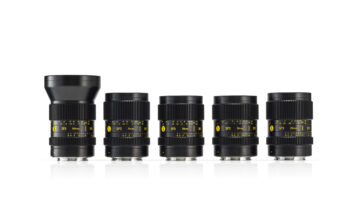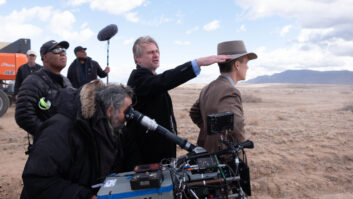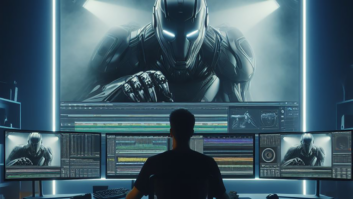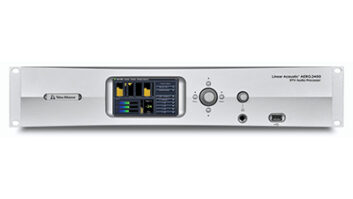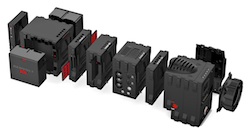
Nowadays, it seems, a camcorder is for life. David Fox reports.
Sony has unveiled a new HDCAM SR camcorder that it says is the most future proof camera it has ever made. The new SRW-9000 is Sony’s answer to the Arri Alexa (TVBEurope, November, page 18) and the Red Epic. It is a modular design that can have 2/3-inch or 35mm sensors, and record on to tape or (by 2011) new solid-state media.
“It’s the camcorder for the future, with the media of the future. It’s the camcorder for life,” said Olivier Bovis, Sony’s general manager, product marketing. “The F900 has lasted ten years and we want the 9000 to last as long.” Buyers’ return on investment was a key factor in its design, and Sony wanted its first one-piece SR camcorder “to be as affordable as possible”, so it costs 7% less than the F900 (at about Eur50,000), “which is astonishing, because this product is amazing,” enthused Bovis.
To make it a practical proposition for restricted drama and documentary budgets, Sony also needed to make HDCAM SR media cheaper, so SR tape prices will be cut by 40%. The SRW-9000 will also be able to act as the baby brother of the F35, because a 35mm migration path (late 2010) will allow owners to swap out the initial 1920×1080 2/3-inch 3-CCD block for a 35mm (single CCD) block. The digital signal processor will remain the same. “This is the first time we’ve created such a modular system,” he said.
Bovis believes the camera will be “a good natural history camcorder, as it can have the high frame rates and long lenses made possible by 2/3-inch, and it can be used for top-end drama with the 35mm block.” By 2011, users will also be able to upgrade the SRW-9000 further, by replacing the tape recorder with a solid-state drive. This will be able to take new SR memory cards, but where its SxS cards have a maximum throughput of 880Mbps, the SR media will be able to record in excess of 5Gbps, allowing one to record eight streams of HD (or one of 4K) – although whether it will record eight streams will depend on how Sony builds the recorder.
Sony hopes to be able to offer a 1TB card, which could record six hours of SR quality, but there will probably be lower capacity cards too, depending on the price point. It will also be the first non-linear media that is RAID 5 protected, which is an important consideration for insurance companies on movie productions, and will be able to record up to 240 frames per second, 1080p 3D and 4K. It will, however, require a new card reader as it won’t fit an Express Card slot (unlike SxS).
The SRW-9000 has been designed to be very heat efficient, enabling it to use a very slow speed fan for cooling, so it should be quieter than even the F900R. It is available now, with the first units in Europe being delivered to TopTeks and Band Pro.
“The advent of a mid-range priced camcorder with a 2/3-inch chip and variable frame rate at full resolution [1-60fps] has been requested by our clients for many years and this kit can do exactly what they want,” said Top-Teks Sales Director and Co-Owner, Mike Thomas. It also “important and reassuring that there is a future proofed path to 35mm and to solid state.
“Achieving the right weight and power consumption to operate handheld was always a concern of our customers. With a physical size equivalent to the HDW-F900 weighing approximately 6.5kg with a battery, Sony has managed the trick of packing nearly all the performance of an F23 while adding greater flexibility to location work,” he added.
An Epic production
The new Red Epic 5K camera should start being delivered to its first buyers soon, although Stage One customers will get what is essentially a prototype shipped as separate components as the parts are ready. They will be beta testers. “It will be somewhat of a pain,” admitted Jim Jannard, Red’s founder.
Stage One is only open to existing Red customers. They won’t be able to trade in their Red One cameras and will pay $28,000 for the Epic X S-35, including camera head, PL mount, a viewfinder, Redmote, one Compact Flash module, a module adaptor, Pro I/O module, Pro Battery module, two batteries and a travel charger. Stage One users will also be able to upgrade their Red One with the new Mysterium-X sensor for $4,500 and get it first.
Further delivery dates are uncertain (as they typically are with Red). “Things will be released when we are finished, and finished properly,” Jannard told members of Red’s user forum. Once full production starts, in early 2010, existing Red One owners can buy them for S19,500, with a slightly lower spec package than Stage One. Sometime later, a trade-in programme for the Red One will enable them to buy an Epic for $10,500.
Eventually, presumably when all the existing Red owners have received their purchases, anyone will be able to buy an Epic X S-35 at $28,000, for the 2.72kg camera head only, although a full camera, with all the necessary components will cost a lot more, depending on what sort of configuration is needed.
The almost 35mm (30mmx15mm) CMOS Mysterium-X sensor will capture 1-100fps at 5K, 1-125fps at 4K, 1-120fps at Quad HD, 1-160fps at 3K, 1-250fps at 2K, and 1-60fps at 1080p (scaled from full frame). It promises increased dynamic range, reduced noise, time lapse, frame ramping, ISO 200-8000.
“The images coming out of the new Mysterium-X sensor have exceeded expectations. The flexibility of the modular system has surprised all of us. The system is significantly better now than when it was first announced,” added Jannard.
Each module is individually upgradeable, and the camera will record both stills and video to Compact Flash, 1.8-inch solid-state drive, Red Drive or Red Ram, using the Redcode 250 codec.
Further versions of Epic and the lower-cost Scarlet system are in development, although the capabilities of Scarlet are being improved (and its prices will be higher).
Stock replacement
A 16mm film camera could becomes the perfect digital capture device. P+S Technik and Lux Media Plan have developed a new digital film magazine that will turn an old Arriflex 16SR 16mm film camera (up to an SRIII) into a digital camera. It includes an N16-size 16:9 sensor and will record lossless compressed RAW HD and 2K to HDD or SDD removable drives. It records up to 30 frames per second in 2K initially, although 75fps recording is planned, and should be available early 2010 for under Eur35,000.
The camera works just as usual, without any film stock, as the 16digitalMag has been designed to be as similar as possible to working with a film magazine, particularly important as the SR16 is so well liked by film crews. Any changes are non destructive and completely reversible. This means that cameras and accessories keep their value, but the postproduction process is dramatically simplified. All Camera functions remain untouched.
The power supply of the 16digitalMag is performed by the camera itself. External power supplies are not necessary for the magazine. An HD-SDI output will be available for video assist. P+S Technik will manufacture the housing, while LMP Lux Media Plan is handling the manufacture of electronic components.
One of the most interesting launches at IBC2008 was the Ikonoskop A-cam dII, a tiny 2/3-inch digital cinema camera recording RAW HD to solid-state cards. However, it is only recently that a camera was shipped to the first buyer – and it was a prototype.
Prototype 2.1 was delivered to Australian cinematographer, Nick Paton (ACS), who has been shooting some test footage, and loves its small size. “I can’t believe I can carry an uncompressed 1080p camera, memory cards, batteries, zoom, 9mm prime and filters in a backpack,” he said. “The camera’s fundamentals are strong, with a low noise sensor recording uncompressed images all in a great form factor. There is a shopping list of improvements already in the works so I can’t wait to see where the final product might take us all.”
The A-cam dII uses a Kodak CCD, and its 80 GB memory cartridge will record 15 minutes of video, audio and metadata. It should run at up to 60fps (which the sensor supports), but is currently working only up to 25fps.
F800’s dramatic entrance
The PDW-F800 is the Sony’s latest to its 50Mbps XDCAM HD422 range, and is particularly interesting for drama production as it can shoot at 24p and be over- and undercranked. It can also record in 1080i and 720p and in various older formats (MPEG IMX, DVCAM and 4:2:0 HD).
An image inverter feature enables the camera to be used with cinema lens adaptors, and gamma settings include HyperGamma and user-selectable gamma curves. A focus assist bar-graph display is visible on the camera’s viewfinder, and users can record proxy data to USB removable media to make transferring data easier and faster.
It also has auto tracing white balance, output markers such as safety, aspect, and centre on the HD-SDI output, slow shutter, interval recording, picture cache recording (up to 30 seconds), disc exchange cache and shock-less gain control. Option boards are available to enable pool-feed operation.
It can also be used with an upcoming Wi-Fi module (that will also work with the F700), which will allow broadcasters or productions to send planning metadata to the camera, and also allow the camera to send a live feed to a mobile phone or laptop, for shot logging and metadata addition on location. The metadata then stays with the disc.
www.ikonoskop.com
www.luxmediaplan.de
www.pstechnik.de
www.red.com
www.sonybiz.net
